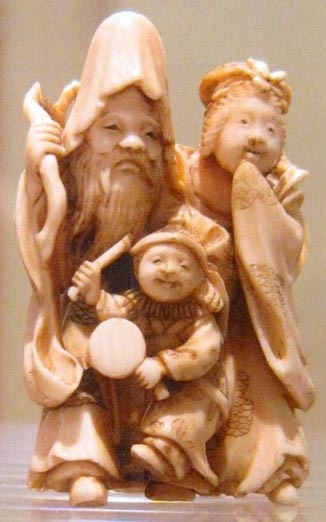
| Print | Back |  |
May 18, 2015 |
 |
Moments in Art Pocket Poachingby Lawrence Jeppson |
How would a man cope if he had no pockets?
Where would he keep his billfold, Swiss army knife, coins, pens, packs of small palate pleasures, passport, used Sunday printed programs?
Japanese Samurai (and others) wore long, flowing robes. They had no pockets. Instead, they carried their small possessions in small boxes or bags. But where would they carry their boxes and bags? Certainly not around in their hands. That would be an inconvenience to sword swinging or food chopsticking.
The Japanese men tied wide sashes around their robes. And to these they hung small containers carrying their small possessions. To fasten the thongs to their girdling they devised small, two-hole toggles called netsukes (pronounced net-skeese, in the plural).
From the simple and nondescript, netsuki evolved. There was no set material, no set pattern. In time the Japanese netsuki became small-scale sculptures. Like Japanese gardens, they became works of art beckoning the best masters. Sometimes the small carvings would be signed, mostly not.
The golden age of Netsuki was the long Tokugawa era, 1603-1867. Carving of netsukis became a means of self-expression, and the art/craft thrived long after the toggle need was gone.

The netsuki could be carved from stone, wood, bone, or ivory. Today, in the United States, importation, sale, or trade of an elephant ivory object is forbidden. However, there are no restrictions to netsukis and other objects made from mammoth bones. Evidently there are great deposits of these in Siberia.
There is no subject matter limitation. A netsuki might depict any animal, plant, mythological creature, god, zodiac figure, or natural event.
A few weeks ago I wrote about my mercurial friend Ed, who ran an antiques shop in Bethesda, Maryland, not far from the campus of the National Institutes of Health. Ed had a collection of several dozen netsukis, for sale individually. The whole caboodle was shoplifted. Ed was certain he knew the identity of the thief. He alerted authorities.
I’m a little fuzzy now on the details. What I remember is that the thief conspired to sell the collection in a deal that would take place aboard an airplane, but whether over some inexact, moving, state-line place above the country or above the ocean, I’m not sure. That might cause question about legal jurisdiction. This, however, was a moot question for the FBI.
FBI agents arrested the thief, and the agent in charge returned the collection to Ed. To prosecute the thief the Feds needed an evaluation of the collection, and this could not come from the owner.
Ed dumped the challenge in my lap.
For weeks, literally, I sat with several dozen netsukis spread across my cleared-off desk, as I studied them one by one, over and over again. I consulted books, Asiatic friends, and whatever sales and auction records I could scare up. Unfortunately, this was long before our era of internet resources.
I found my best book on the subject, Netsuke by Joe Earle, 2001, many years too late. It was published by the Museum of Fine Arts, Boston, and was subtitled Fantasy and Reality in Japanese Miniature Sculpture. This was at a time when my friend Jonathan Fairbanks, about whom I have written, was curator of decorative arts and sculpture at the museum.
An earlier book, 1977, was Netsuki by Frieder Aichele Gert Nagel, a cheaply printed translated paperback from The Collectors Library colophon of Popular Library. Germans seem to have an overpowering compulsion to subdivide and classify information, and this book is typical. Going yellow with age, it is of valuable technical help but of miserable lacking in illustrative thrill.
The more I studied my strewn netsukis, the more enamored I became. I kept wishing I had the means to collect.
Some of the netsukis were very old, very valuable. Some were post-WWII, not so precious. They ran the gamut of subject matter. I admired fantasy figures, animals, birds, scenery, fables. But if I were to become a collector, there is one netsuki subject that absolutely enthralled me: depictions of everyday life. Fishermen, fish mongers, hunters, drum-makers, potters, farmers, merchants, sailors, wheel-makers, artists, woodcutters, and others.
Behind many of the netsukes were the fables, folklores, and incidents they told. As part of my appraisals, I had to interpret the small sculptures, retell the stories.
When I was done, I met with Ed and the FBI agent, reluctantly returned the desktop of captivating figures, along with my appraisal.
Alas, I was never able to pursue my acquisition of even a single netsuke, although I always look at them in museums.
I mentioned once in passing that the worst mistake I ever made was the purchase of a 1977 Italian Lancia sport sedan. It was fun to drive, stick shift and all, but constant repairs were driving me to the poorhouse. But I got rid of it. I sold it to the FBI agent in charge. He said he was a good mechanic and could cope with it. It became his jurisdiction. I never saw him again.
| Copyright © 2025 by Lawrence Jeppson | Printed from NauvooTimes.com |